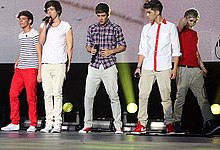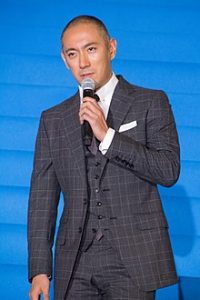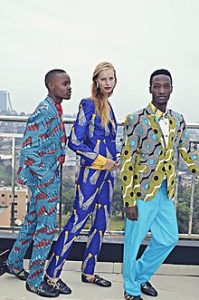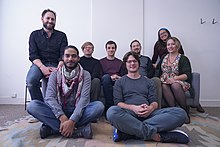Men’s clothing
Early 2010s (2010–2012)
Neon colors

Neon colors and elaborate T-shirts were popular for much of the early 2010s, especially graphic print hoodies, novelty socks, red or blue skinny jeans, studded belts with large buckles, and Ed Hardy T-shirts embellished with rhinestones.[138]
1990s revival
In the summer of 2011, 1980s and 1990s inspired fashion made a comeback in the UK among men. This included bright colored short shorts, jeans shorts with a stone wash or acid wash, shorter 7, 6, and 5 inch inseam shorts from mid 2010s on, shirts with Aztec patterns, Mayan patterns, camouflage prints or 19animal prints, flannel shirts, high top sneakers, snapback hats, and gaudy wristwatches.[148]
Business casual

The business casual look of the 1990s and early 2000s remained common in many parts of the Americas, with jeans, loafers, boat shoes and sneakers being seen as acceptable to wear in the workplace.[155] The decline in the formality of men’s fashion that started in the 1960s continued until 2012, with men wearing informal clothing on a regular basis, even at work or while travelling, as an apparent extension of Beau Brummell‘s older idea that gentlemen shouldn’t try to outshine the ladies for attention.[citation needed] This contrasted to Britain, Italy, Europe, and parts of the US, where more formal Mad Men-inspired business clothing such as slim-fitting grey two piece suits had made a comeback in the workplace during the early 2010s.[156] At this time, tweed cloth sportcoats became acceptable town wear, and business suits imitated the broad shouldered, form fitting styles of the 1920s,[157] sometimes with contrasting lapel piping.
Mid 2010s (2013–2016)
Workwear and luxury sportswear
From 2013 to 2015, men’s fashion was heavily influenced by the improving economy and fashion-conscious cities such as London, New York City, Paris, and Milan, and incorporated elements of hip-hop fashion, luxury fashion, sportswear, athleisure and skater apparel. Bright colors, studded belts and retro styled graphic prints[158] (especially 1960s–80s advertising logos, classic rock bands, and the loud Ed Hardy shirts) went out of style in favor of plain black, white, beige, taupe, gray, marl, burgundy, and various shades of dark green.
Formal business wear

In the UK, Italy, Australia[181] and US, many professional men wear grey mohair or houndstooth office suits, usually with two-button fastening, a single vent, and narrow lapels[182] inspired by the American TV show Mad Men, Hannibal, and Daniel Craig as James Bond.[183][184][185] Businessmen in Asian countries like the Philippines generally followed the trend, but dispensed with the necktie in favor of a semi-formal, simple shirt better suited to the hot tropical climate. As part of the general 1980s revival, the waistcoat[186] made a comeback as part of the three piece suit in Europe and the US. In the early 2010s these suits were mostly charcoal grey,[187] shiny steel grey and silver[188] (especially in Australia and America),[189][190] but by 2014 these were joined by air force blue, navy blue,[191][192] midnight blue,[193] and sky blue.
African fashion

The mid-2010s witnessed the beginnings of Africa’s own haute couture[207] due to increased restriction on secondhand mitumba clothing in Kenya and Uganda.[208] Mozambican designer Taibo Bacar was the first African fashion brand to debut at Milan Fashion Week in 2010 and became one of Africa’s leading fashion houses, proving that African fashion can compete on the world stage.[209]
Late 2010s (2017–2019)
Relaxed look

By November 2018, fashion designers in the US and other countries began to move away from the slim fitting casual attire and frequently combined business casual pieces with sportswear.[215] Brown replaced black as the most popular color for leather jackets, and common accessories included orange hoodies, black track pants, faded jeans covered in iron-on patches, black[216] or white leather hi-tops,[217] Timberland boots, navy blue wool coach jackets, graphic print tees featuring a small statement design,[218] dark flannel sportcoats, cambric shackets, or camouflage jackets layered over cardigans or Alpine patterned sweaters,[219] and white Adidas sneakers.[220] From 2018 to 2020, baggy[221] cargo pants with external pockets were reintroduced, skate shoes declined in popularity,[222] and long tweed coats became popular.[220]
1970s and Britpop influences
Beginning in March 2017, clothing inspired by 1990s Britpop, mod revival[227][228] and 1970s fashion[229] became popular among young men in the US, UK, Australia, Canada, Ireland, Italy,[230] Hong Kong, and France,[231] especially in beige, cream, sand, orange, blue, brown, dark green, ecru, red, pistachio, and complementary neutral tones.